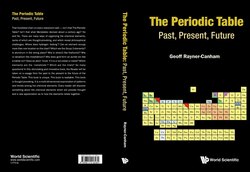Читать книгу The Periodic Table - Geoff Rayner-Canham - Страница 8
На сайте Литреса книга снята с продажи.
ОглавлениеIntroduction
“Periodic Properties? That’s easy! Properties down a couple of Groups, properties across a sample Period, done!” A not uncommon view. Yet there is a richness of relationships, some obvious, some not, which makes an in-depth look at the chemical elements a rewarding adventure. Ronald Rich eloquently described the lure of periodicity in all its manifestations:
One of the fascinations of inorganic chemistry is the existence of a wide variety of relationships among the elements and their properties-relationships that show an encouraging degree of order, but a tantalizing variability and novelty. These qualities make the “family of elements” an apt metaphor: while members of a family have much in common, each member also has his[/her] own individual personality.
There have been some 20th century monographs on chemical periodicity. However, to be honest, the old Periodic Table monographs are boring … no, very boring … no extremely boring. As are the chapters on the Periodic Table in most textbooks. A litany of dry facts usually emphasizing that everything can be explained in terms of Groups and Periods; that everything is known; that there is only one definitive Periodic Table; and that apart from the genius of Mendeléev, rarely is any other human involvement described.
How incredibly far from the truth in all these factors!
•The Periodic Table is fascinating — as I hope, you, the Reader, will discover.
•Groups and Periods are only one small facet of linkages among the chemical elements.
•There are still avenues of exploration and with many discoveries, new possibilities arise.
•There is no one-fits-all-uses Periodic Table — there are different arrangements to better explain some aspect of element linkages.
•The Periodic Table is a human construct, as can be seen from the names mentioned herein. And in recent times, seven individuals, in particular, have contributed greatly to modern philosophies of the Periodic Table and of the elements therein: Stephen Hawkes, William Jensen, Michael Laing, Pekka Pyykkö, Guillermo Restrepo, R. T. Sanderson, and Eric Scerri. The Reader will see their names (and many others) sprinkled in the text and among the Chapter References.
This book is not a data-filled comprehensive (and boring) compilation. Instead, by looking at some patterns and trends from different perspectives, the Author hopes that the Reader will find this book stimulating and thought-provoking. Without doubt, there are additional interesting and/or curious linkages and patterns of which the Author is unaware. Any Reader spotting an overlooked similarity or pattern is asked to bring it to the attention of the Author at: grcanham@grenfell.mun.ca.
In closing, my Grenfell colleague Chris Frazee, and my partner, Marelene Rayner-Canham, are thanked for reading the entire manuscript (Marelene, many times) in an endeavor to minimize the errors therein.
Geoff Rayner-Canham
